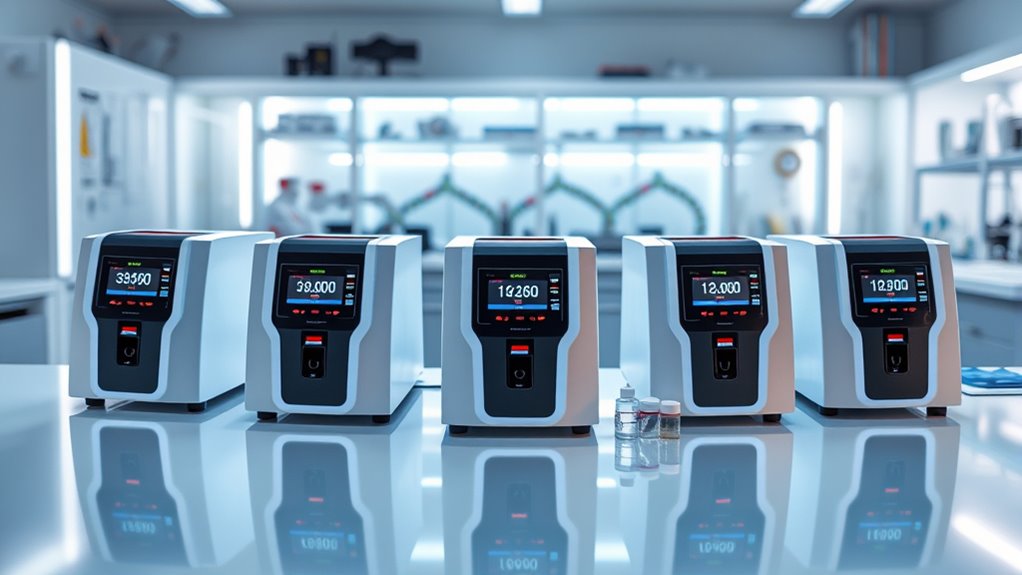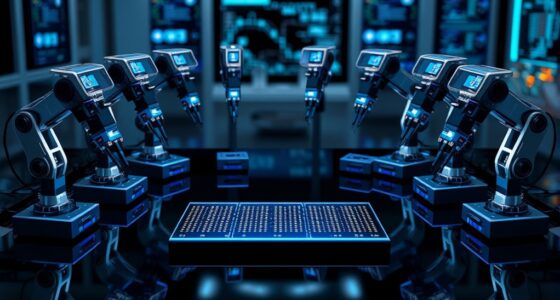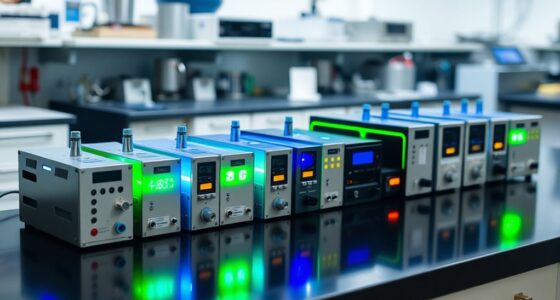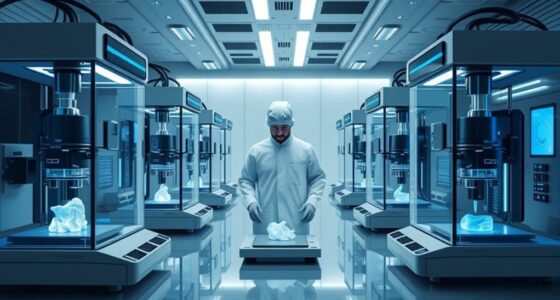If you’re looking for the top DNA synthesizers in 2025, I recommend considering models that combine high precision, low error rates, and seamless automation. Key features to seek include automated calibration, robust data storage, compatibility with lab networks, and minimal manual maintenance. Devices like advanced synthesizers now support cloning, gene editing, and long DNA strands efficiently. Stay tuned, as I’ll guide you through the best options and what makes them stand out.
Key Takeaways
- Prioritize synthesizers with high accuracy (error rates below 1 in 10,000) for reliable DNA sequence production.
- Choose models offering extensive storage, automation, and calibration features to enhance efficiency and minimize manual maintenance.
- Select devices compatible with lab networks, LIMS, and automated quality control for seamless workflow integration.
- Opt for synthesizers with minimal setup time, user-friendly interfaces, and robust error detection to maximize throughput.
- Consider cost-effective options balancing advanced features, durability, and long-term operational expenses for lab sustainability.
Liven Evoke Acoustronic Synthesizer with Granular Effect
https://m.media-amazon.com/images/I/71iXzZImICL._AC_SX679_.jpg
If you’re into creating cinematic ambient or post-classical sounds on the go, the Liven Evoke Acoustronic Synthesizer with Granular Effect is an excellent choice. It’s portable, lightweight, and features a robust “Acoustronic Flux Oscillator” engine, blending 34 acoustic tones with wavetables and noise options. The Grain FX granular effect, supporting up to 12 grains, adds organic textures, tempo-syncing, and external source processing. With a built-in speaker and versatile connectivity, it’s ideal for spontaneous soundscapes. Its 4-track sequencer and chord modes simplify complex performances. Despite some limitations like plastic keys and no presets, users love its affordability and creative potential for cinematic sound design.
Best For: musicians and sound designers seeking a portable, versatile synthesizer for cinematic, ambient, or post-classical music creation on the go.
Pros:
- Lightweight and highly portable, ideal for mobile use and spontaneous performances
- Rich sound engine combining acoustic tones with granular effects and multiple wavetables
- Intuitive 4-track sequencer and chord modes simplify complex sound design and live play
Cons:
- Plastic keys may feel less comfortable compared to rubber or weighted keys
- Lack of preset sounds can increase setup time for new users
- Unclear stereo input configuration might cause confusion during connectivity setup
Liven Ambient Ø Soundscape Synthesizer

The Liven Ambient Ø Soundscape Synthesizer is an excellent choice for ambient musicians and sound designers who seek rich, evolving soundscapes on the go. Its 4-layer generator combines Drone, Pad, Atmos, and Noise, all modulated through Blendwave Synthesis with 6 structures and 32 waves for undulating tones. The Noise layer supports sampling, pitch control, and stereo input, adding custom textures. Deep effects like lush reverbs, delays, overdrive, and modulation enhance spatiality and movement. With 64-step sequencers per layer, real-time performance, and microtonal tuning options, the device offers versatile, portable ambient soundscaping perfect for live, studio, or field use.
Best For: ambient musicians, sound designers, and live performers seeking portable, richly textured soundscapes with versatile modulation and sampling capabilities.
Pros:
- Combines four distinct layers (Drone, Pad, Atmos, Noise) for complex, evolving textures
- Supports microtonal tuning and extensive pattern sequencing for creative flexibility
- Equipped with deep effects including reverb, delay, overdrive, and line-in processing for immersive sound design
Cons:
- May have a learning curve due to its numerous modulation and sequencing options
- Limited built-in storage options for large sample libraries on the device itself
- Battery life and portability could be constrained by power consumption during extensive effects processing
B3 Deluxe Theremin

The B3 Deluxe Theremin stands out as an approachable and versatile instrument ideal for beginners and hobbyists exploring electronic soundscapes. Its modern design features a textured painted wooden cabinet, making it both stylish and durable. Weighing just 3.9 pounds, it’s portable and easy to set up, with pitch and volume antennas for intuitive control. The five-octave range and adjustable pitch make it suitable for various musical styles, from sci-fi to classical. While it offers good sound quality and compatibility with external devices, interference can sometimes be an issue. Overall, it’s a fun, cost-effective way to get started with theremins and electronic music.
Best For: beginners, hobbyists, and educators seeking an affordable and easy-to-use theremin for learning and fun performances.
Pros:
- User-friendly design with intuitive pitch and volume control antennas
- Compact and lightweight, making it highly portable
- Compatible with external amplifiers and devices for versatile sound options
Cons:
- Susceptible to electronic interference and static issues
- Not suitable for professional or highly demanding performances
- May require aftermarket accessories for optimal mounting and setup
Liven 8bit Warps 8-bit Synthesizer with Looper
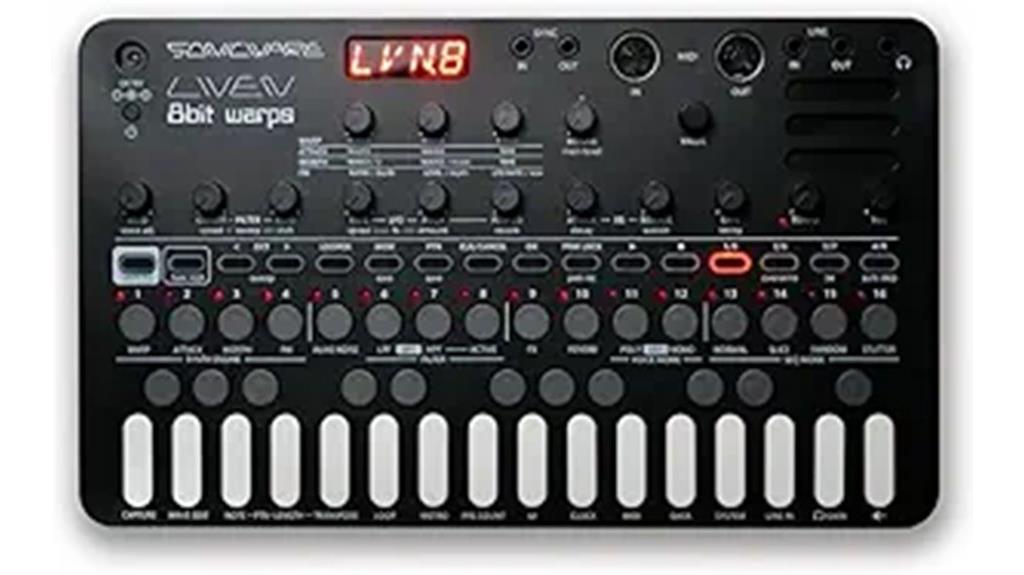
Liven 8bit Warps stands out as the perfect choice for musicians and sound designers who want portable, hands-on control over retro-inspired soundscapes. Its compact design, battery-powered operation, and built-in speaker make it ideal for on-the-go creativity. Equipped with an 8-bit waveform engine, it produces a wide range of sounds from chiptune to ambient textures. The 4-track looper and 128-step sequencer with parameter locking enable complex pattern creation. Plus, with 10 effects and a cassette tape simulator, you can shape your sounds creatively. Weighing just under 2 pounds, it’s a versatile, portable tool for dynamic sound design anywhere.
Best For: musicians and sound designers seeking portable, hands-on control over retro-inspired soundscapes for on-the-go music creation and sound design.
Pros:
- Compact, lightweight design with built-in speaker for portability
- Versatile sound engine supporting a wide range of genres from chiptune to ambient
- 4-track looper and 128-step sequencer with parameter locking for complex pattern creation
Cons:
- Constructed from plastic, which may feel less durable over time
- Limited to 49 keys, which might restrict playing range for some users
- Battery operation may require frequent replacements for intensive use
GOWENIC DMA Fuser Synthesizer for Video Conferencing
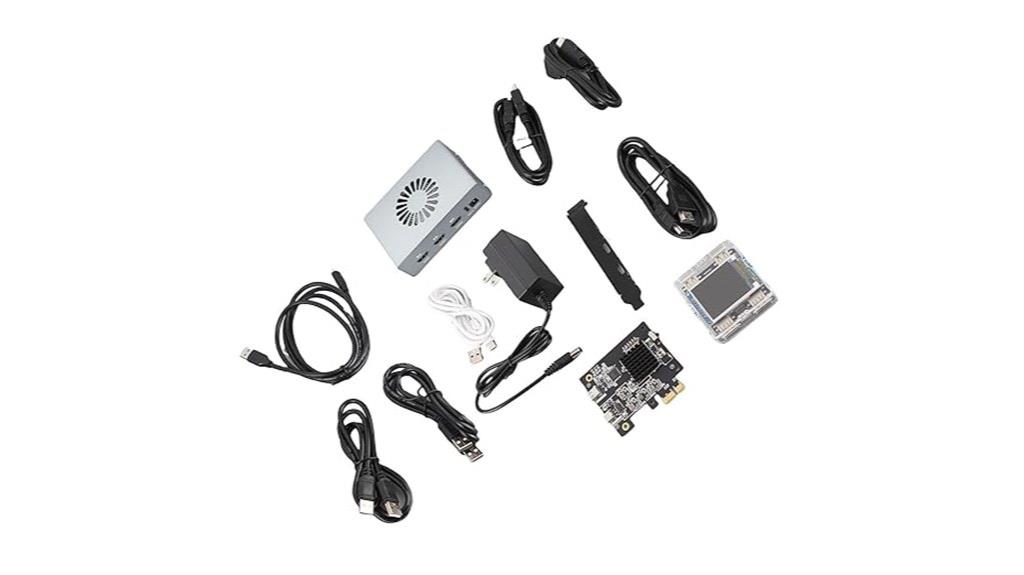
GOWENIC DMA Fuser Synthesizer excels in high-stakes environments like financial trading rooms and emergency control centers, where crystal-clear video quality and seamless data transfer are essential. It offers lossless HD video at resolutions up to 3840×2160 at 60Hz, ensuring sharp visuals. Its built-in temperature-controlled fans guarantee stable operation during intensive use. The device’s plug-and-play design simplifies setup, making it easy to integrate into existing systems. Supporting dual inputs and overlay blending, it provides versatile multimedia capabilities. With its efficient DMA technology, it enables rapid, high-bandwidth data transfer between devices, making real-time video processing smooth and reliable even under demanding conditions.
Best For: professionals in financial trading, security, and traffic management environments seeking high-quality, seamless video conferencing with high-resolution output.
Pros:
- Supports lossless HD video at 3840×2160@60Hz for crisp, clear visuals
- Dual input capability with overlay blending for versatile multimedia presentations
- Plug-and-play design with built-in cooling ensures easy setup and stable operation
Cons:
- Requires two computers to operate, which may increase system complexity
- Dependence on PCIe connection might limit compatibility with older systems
- High-resolution support may demand substantial bandwidth and hardware resources
BeatBuddy 10th Anniversary Drum Machine
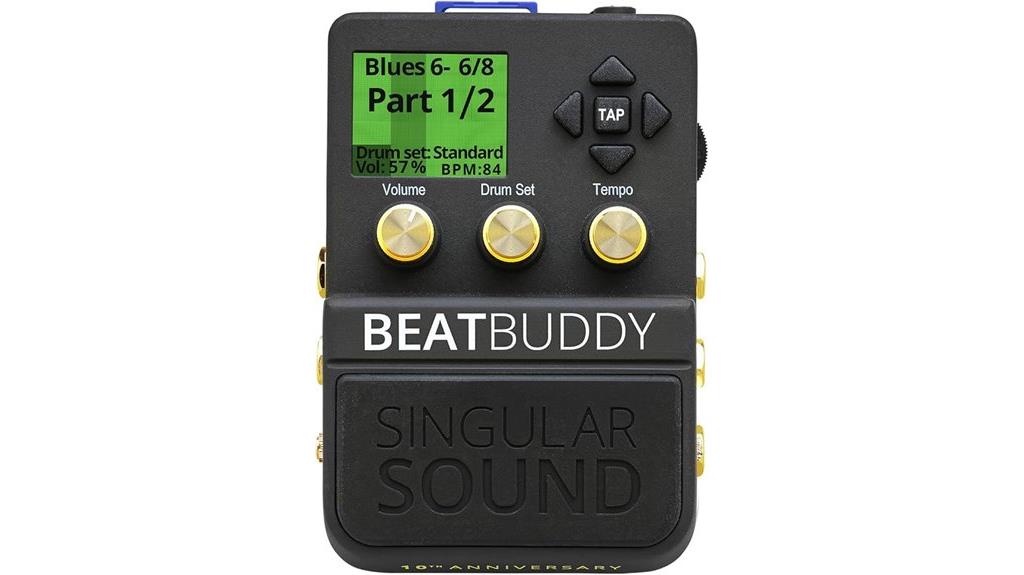
If you’re a musician seeking a realistic and easy-to-use drum machine for live performances, studio work, or practice, the BeatBuddy 10th Anniversary Drum Machine is an excellent choice. It’s compact, lightweight, and built to last, weighing just 1.15 pounds with a user-friendly interface, including a full-color LCD and visual cues for timing. Its extensive library offers over 200 songs across 24 genres, with realistic sounds that mimic a real drummer’s nuances. The device allows hands-free control via foot switches, making live performance seamless. Reliable and versatile, it’s perfect for enhancing rhythm accuracy, songwriting, and practice without the complexity of traditional drum machines.
Best For: musicians who need a realistic, easy-to-operate drum machine for live gigs, studio recording, or practice that enhances their rhythm skills and songwriting with minimal setup.
Pros:
- Studio-quality sound that mimics a real drummer’s nuanced performance
- User-friendly interface with visual cues and full-color LCD for easy navigation
- Hands-free control via foot switches allows seamless live performance transitions
Cons:
- Higher price point compared to some other drum machines
- Limited drum kit options available for purchase
- Does not support direct guitar input, focusing solely on percussion sounds
Nanobox Lemondrop Granular Synthesizer Module
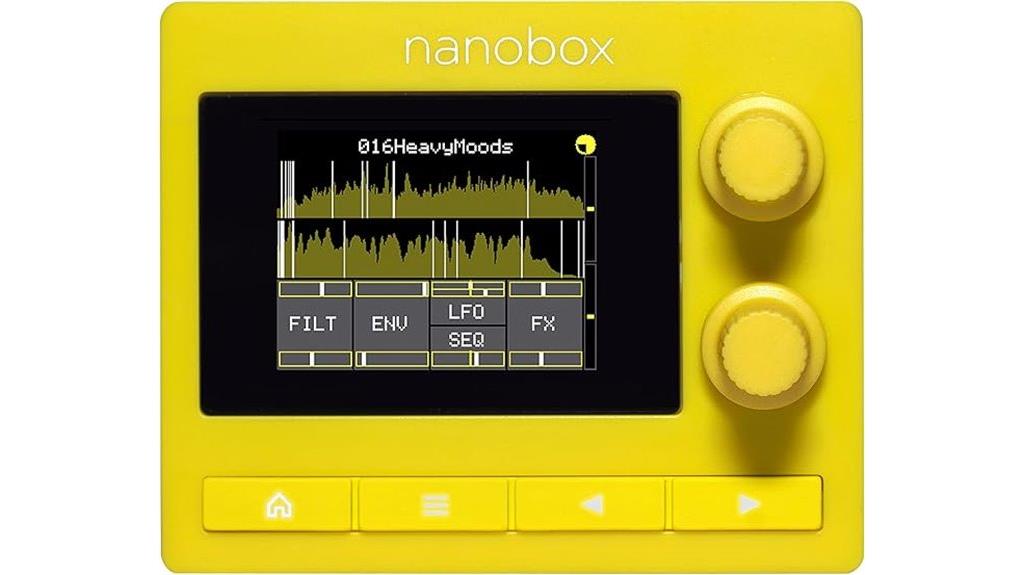
The Nanobox Lemondrop Granular Synthesizer Module stands out as an ideal choice for musicians and sound designers who need a portable, versatile instrument capable of crafting rich textures and experimental sounds on the go. Its pocket-sized design, measuring just 7.6 by 4.85 inches, packs a powerful, flexible synth engine that combines two WAV-based granular oscillators with an additional oscillator, supporting four-voice polyphony. It offers intuitive touch controls, multiple connectivity options, and support for custom WAV files, making it perfect for live performance or studio use. USB-powered and lightweight, the Lemondrop delivers professional-grade sound shaping in a compact package, ideal for creative exploration wherever inspiration strikes.
Best For: musicians, sound designers, and producers seeking a portable, versatile granular synthesizer for live performance and studio experimentation.
Pros:
- Compact, lightweight design ideal for portability and on-the-go use
- Supports custom WAV files and offers a flexible, powerful sound engine with multiple effects
- Seamless integration with MIDI controllers, DAWs, and other gear through comprehensive connectivity options
Cons:
- Customer reviews indicate a mixed satisfaction level with a rating of 3.8 out of 5 stars
- Limited to 4-voice polyphony, which may be restrictive for complex arrangements
- Small touchscreen controls may pose challenges for precise editing or those with larger fingers
Factors to Consider When Choosing DNA Synthesizers for Labs
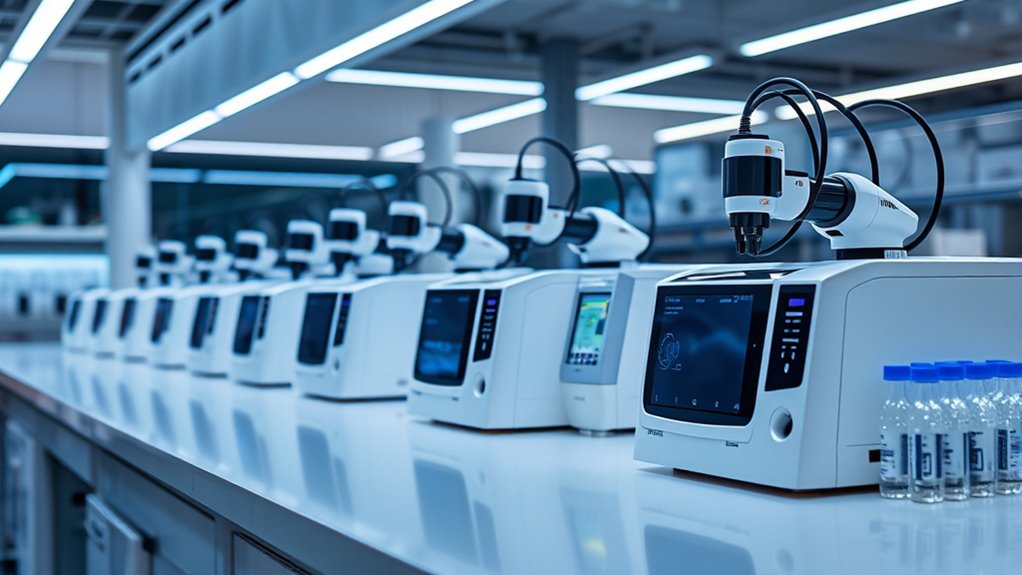
When selecting a DNA synthesizer, I focus on factors like accuracy and precision to guarantee reliable results. Compatibility with existing lab systems and ease of calibration are also vital for smooth operation. Additionally, I consider data storage capacity and user interface design to optimize workflow and user experience.
Accuracy and Precision
Choosing the right DNA synthesizer requires careful consideration of both accuracy and precision, as these factors directly impact the fidelity of the synthesized sequences. Accurate synthesizers reduce errors during chemical assembly, guaranteeing high-quality DNA with minimal sequence mistakes. Essential is measured by error rates per base, and advanced models can achieve rates below 1 in 10,000 bases, which is crucial for producing long, reliable strands. High-precision systems often include real-time quality control, like fluorescent detection, to monitor and correct errors immediately. Consistency in results, achieved through precise reagent delivery and controlled conditions, is indispensable for reproducibility in research. Prioritizing these factors ensures the synthesized DNA will meet the demanding needs of downstream applications such as cloning, gene editing, and functional studies.
Compatibility With Lab Systems
Ensuring that a DNA synthesizer integrates smoothly with your laboratory’s existing systems is vital for efficient workflow. I look for devices compatible with my current hardware, such as computers and peripheral devices, to avoid unnecessary upgrades. Support for standard communication protocols like USB, Ethernet, or RS-232 guarantees seamless connection to lab networks. It’s also essential that the synthesizer’s software can integrate with our Laboratory Information Management System (LIMS) or other data platforms, streamlining data handling. I verify that the data output formats align with our analysis tools and storage infrastructure to prevent compatibility issues. Additionally, I consider reagent and consumable compatibility, ensuring they fit within our supply chain and storage capabilities. This holistic approach minimizes disruptions and maximizes operational efficiency.
Ease of Calibration
Have you ever considered how much easier your lab work becomes with a DNA synthesizer that’s simple to calibrate? A device with straightforward calibration procedures allows me to make quick, accurate adjustments to nucleotide coupling efficiency, reducing downtime. Many top synthesizers feature automated routines that minimize manual effort, making calibration less of a hassle. Consistent calibration is essential for maintaining sequence fidelity, especially when working with complex or lengthy DNA strands. Some models include built-in calibration standards or reference controls, simplifying performance verification and adjustments. Regular calibration capabilities and user-friendly procedures ensure reliable, reproducible results—crucial for high-throughput or sensitive applications. Choosing a synthesizer with easy calibration ultimately saves time, enhances accuracy, and boosts overall lab efficiency.
Data Storage Capacity
When selecting a DNA synthesizer for your lab, data storage capacity plays a critical role in maintaining smooth and efficient workflows. Adequate storage allows you to handle large volumes of sequence data and extensive project libraries without frequent interruptions for data transfers. It also makes it easier to preserve multiple synthesis protocols, custom sequences, and calibration data, supporting versatile research needs. Storing high-resolution sequence data locally reduces reliance on external devices, streamlining operations. Some models offer expandable storage options, so your capacity can grow with your projects. Having sufficient space is essential for maintaining detailed audit trails, quality control records, and regulatory documentation. In short, choosing a synthesizer with ample storage ensures your lab runs efficiently and stays compliant with record-keeping requirements.
User Interface Design
Choosing a DNA synthesizer with a user-friendly interface is essential for smooth laboratory operations. An intuitive design with clear visual cues and a logical layout makes it easier to operate and reduces training time. Touchscreen controls, customizable menus, and tactile feedback can notably boost workflow efficiency and user satisfaction. Well-organized navigation, with straightforward function grouping and simple parameter adjustments, minimizes errors during complex synthesis protocols. Real-time status indicators and error alerts help me monitor progress and troubleshoot quickly, avoiding delays. Compatibility with external devices and software ensures seamless integration into existing lab setups, streamlining processes. Overall, a thoughtfully designed interface enhances accuracy, speeds up work, and makes the DNA synthesis experience more straightforward for everyone involved.
Cost and Budget
Selecting a DNA synthesizer involves more than just considering its features; cost and budget play a significant role in making the right choice. These devices can range from a few thousand dollars for basic models to hundreds of thousands for high-throughput, automated systems. Your budget often determines whether you can afford advanced features like longer sequence support or lower error rates. Remember, the initial purchase price isn’t the only expense—ongoing costs like reagents, maintenance, and replacement parts add up over time. It’s essential to balance what you need with what you can afford, ensuring the synthesizer aligns with your lab’s financial planning. A careful assessment of both upfront costs and long-term expenses helps you select a device that provides value and efficiency without breaking the bank.
Maintenance Requirements
Maintaining a DNA synthesizer requires regular attention to guarantee it performs at its best. I keep up with calibration and cleaning of key components like reagent delivery systems and reaction chambers to accuracy and consistency. Some models need routine replacement of consumables such as cartridges, tips, and filters, which can affect ongoing costs and effort. I also prioritize software updates and troubleshooting protocols to keep the device compatible with evolving standards and minimize downtime. Managing waste disposal, especially hazardous chemicals, is vital for safety and compliance. Automated features like self-cleaning cycles and diagnostic checks help reduce manual effort and improve reliability. Overall, understanding these maintenance needs helps me select a model that’s efficient, cost-effective, and easy to keep running smoothly.
Frequently Asked Questions
How Do DNA Synthesizers Ensure Accuracy in Gene Assembly?
DNA synthesizers guarantee accuracy by using high-quality reagents and precise control over each nucleotide addition. I pay close attention to the phosphoramidite chemistry process, which includes rigorous purification steps to minimize errors. Real-time monitoring systems catch mistakes early, and software algorithms optimize synthesis cycles. By combining these techniques, I can reliably produce accurate gene sequences, reducing errors and ensuring high fidelity in my DNA assembly projects.
What Safety Measures Are Essential for Lab DNA Synthesizers?
Ever wonder how labs keep DNA synthesizers safe? I make certain to follow strict safety protocols like wearing protective gear, handling chemicals carefully, and maintaining proper ventilation. Regular equipment checks and software updates are essential too. Don’t you think safety should always come first? Keeping these measures in place helps prevent accidents and ensures reliable results, letting us focus on groundbreaking research without risking health or data integrity.
Can DNA Synthesizers Be Used for Custom or Rare Sequences?
Absolutely, DNA synthesizers can be used for custom or rare sequences. I’ve found that most modern machines allow for easy input of unique sequences, making it simple to produce specialized DNA strands. They’re designed to handle complex and less common sequences efficiently, giving researchers like us the flexibility to work on niche projects or innovative designs without hassle. It’s a real game-changer for personalized and advanced genetic research.
What Maintenance Routines Extend the Lifespan of DNA Synthesizers?
Think of your DNA synthesizer as a finely tuned instrument; regular maintenance keeps its symphony playing smoothly. I recommend daily cleaning of the nozzles, weekly calibration checks, and monthly replacement of consumables. Avoid dust buildup and guarantee proper cooling. Regular software updates also help prevent errors. These routines act like a gentle tune-up, extending its lifespan and maintaining precision, so your lab’s work remains reliable and efficient over time.
How Do Costs Compare Between Different DNA Synthesizer Models?
Costs between DNA synthesizer models vary widely. I’ve found that high-end models with advanced features tend to be more expensive upfront, but they often reduce long-term costs through greater efficiency and lower maintenance. Mid-range options might save money initially but could incur higher replacement or repair costs over time. It’s essential to take into account total cost of ownership, including maintenance, consumables, and performance, to make the best financial choice.
Conclusion
Choosing the right DNA synthesizer is like selecting the perfect instrument for a symphony—each one offers unique notes of precision and efficiency. As you navigate this tech landscape, remember that the best tool isn’t just about features but about how it helps you compose breakthroughs. In this game of innovation, your choice will echo through discoveries, proving that with the right synthesizer, you’re not just building DNA, you’re shaping the future.
